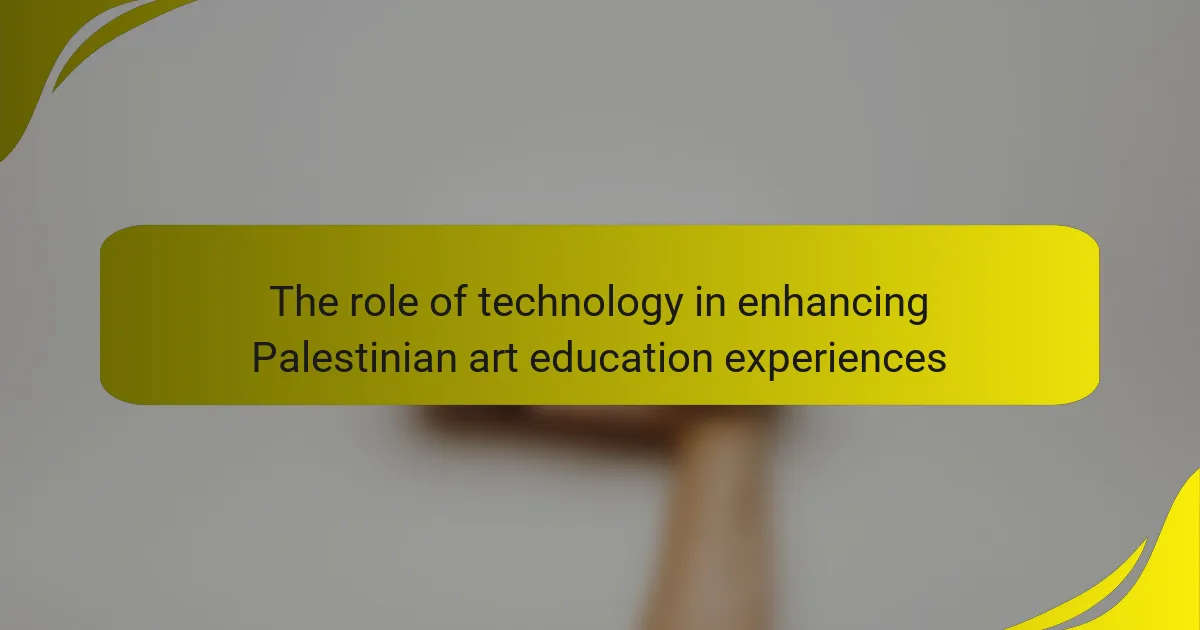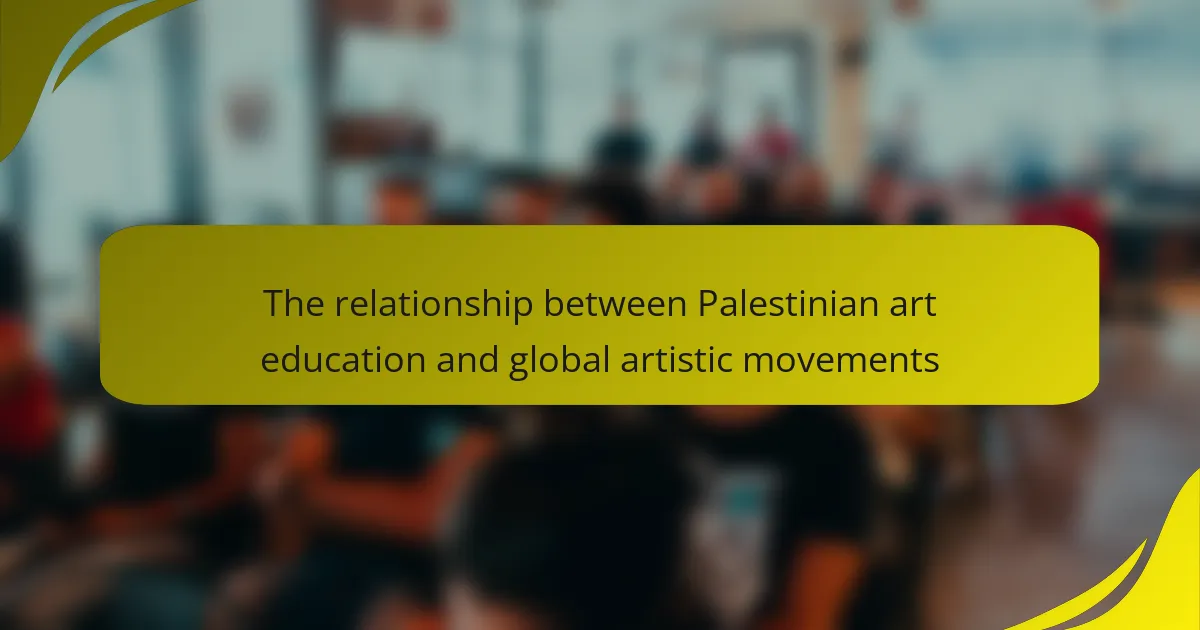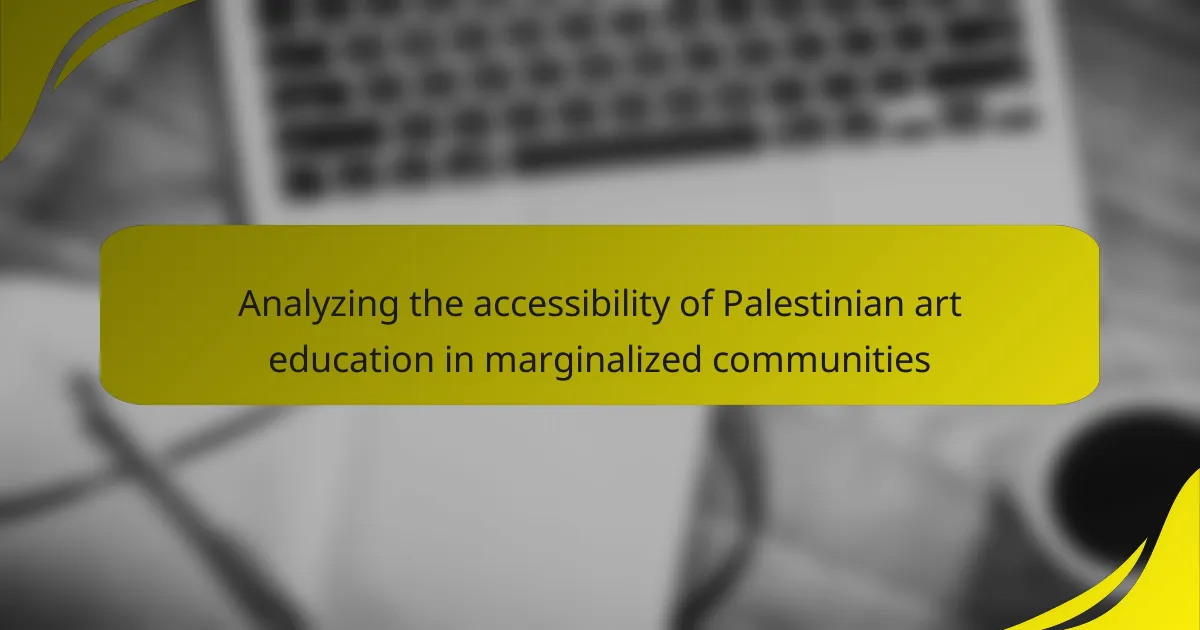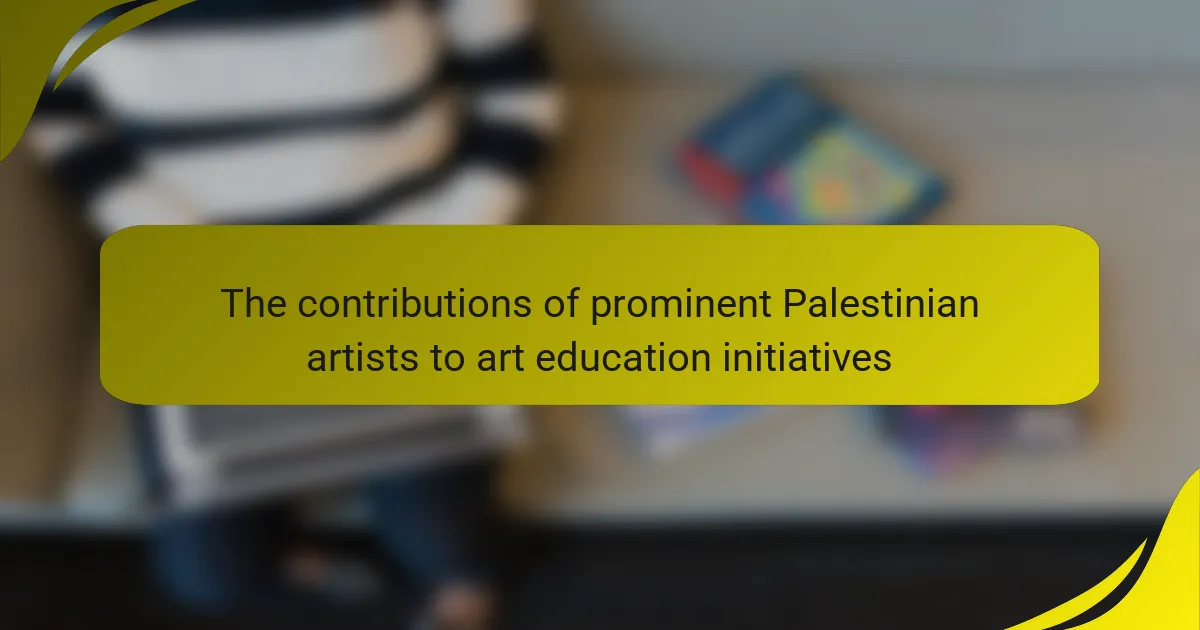Palestinian art education is a vital component in promoting community resilience and empowerment. It equips individuals with essential tools for self-expression, critical thinking, and creativity, allowing them to process trauma and foster solidarity. Despite facing significant challenges such as political conflict, limited resources, and cultural censorship, effective art education initiatives enhance cultural identity and social cohesion. Research indicates that participation in art education not only improves mental health and emotional well-being but also encourages civic engagement among community members. This article explores the multifaceted role of Palestinian art education in strengthening community bonds and preserving cultural heritage.
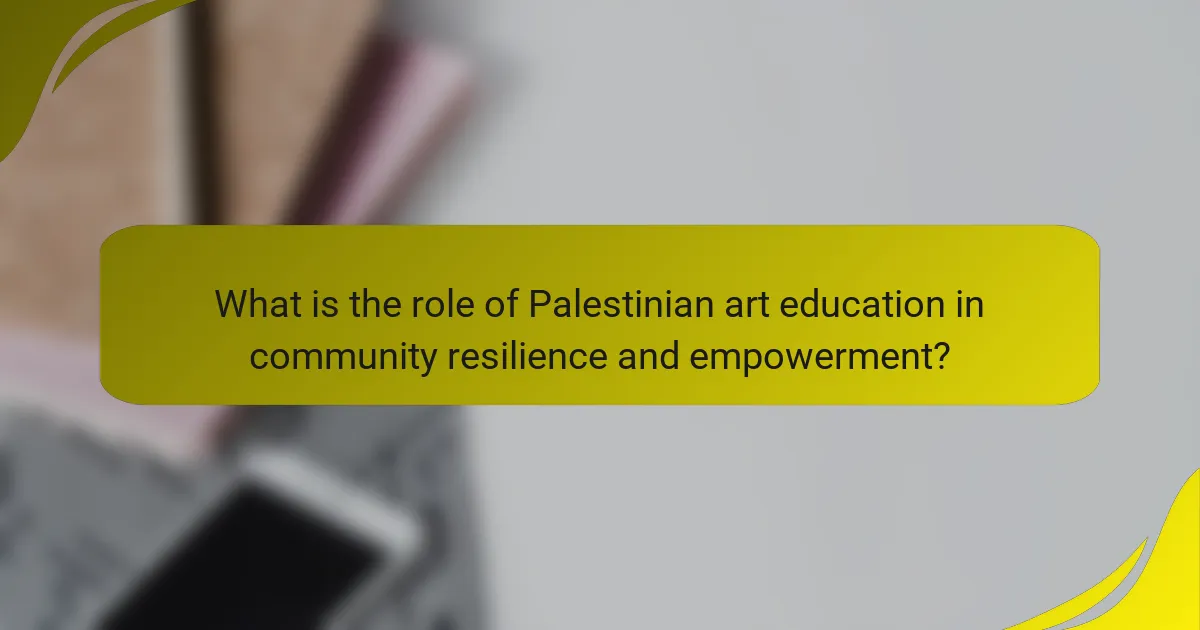
What is the role of Palestinian art education in community resilience and empowerment?
Palestinian art education plays a crucial role in fostering community resilience and empowerment. It provides individuals with the tools to express their identity and experiences. This form of education encourages critical thinking and creativity. By engaging in artistic practices, community members can process trauma and build solidarity. Art serves as a medium for cultural preservation and resistance against oppression. Educational programs often focus on traditional and contemporary forms of art. These programs enhance social cohesion and create a sense of belonging. Research indicates that art education contributes to psychological well-being and social activism within the community.
How does art education contribute to community resilience in Palestine?
Art education contributes to community resilience in Palestine by fostering creativity and critical thinking. It provides a platform for self-expression and cultural preservation. This form of education encourages collaboration among community members. It helps individuals process trauma through artistic outlets. Art education also promotes social cohesion by uniting diverse groups. Programs often address local issues, empowering participants to advocate for change. Research indicates that communities engaged in art initiatives demonstrate increased resilience. For example, the “Art and Resilience in Palestine” study highlights the positive impact of art on mental health and community solidarity.
What are the key elements of art education that foster resilience?
Key elements of art education that foster resilience include creative expression, critical thinking, and collaboration. Creative expression allows individuals to process emotions and experiences, promoting mental well-being. Critical thinking enhances problem-solving skills, enabling students to navigate challenges effectively. Collaboration fosters a sense of community and support, essential for resilience. Research indicates that art education can lead to improved self-esteem and coping strategies. A study by the National Endowment for the Arts found that students engaged in arts education showed increased resilience in facing life challenges. These elements collectively contribute to building a resilient mindset among participants.
How does participation in art education programs strengthen community bonds?
Participation in art education programs strengthens community bonds by fostering collaboration and shared experiences. These programs encourage individuals to work together on creative projects. Participants often develop a sense of belonging through collective artistic expression. Engaging in art promotes dialogue and understanding among diverse community members. Art education can address social issues, creating a platform for discussion and reflection. Research shows that communities involved in art initiatives report increased social cohesion. For example, a study by the National Endowment for the Arts found that arts participation enhances community engagement. Overall, art education programs build connections that enhance community resilience and empowerment.
Why is empowerment through art education significant for Palestinian communities?
Empowerment through art education is significant for Palestinian communities because it fosters self-expression and cultural identity. Art education provides a platform for individuals to share their experiences and perspectives. This expression is crucial in communities facing oppression and conflict. Engaging in art helps individuals process trauma and promotes mental well-being. Studies show that creative outlets can enhance resilience in marginalized populations. Furthermore, art education cultivates critical thinking and problem-solving skills. These skills are essential for community development and social change. By nurturing creativity, Palestinian art education strengthens community bonds and promotes unity.
What skills do individuals gain through art education that lead to empowerment?
Art education equips individuals with critical thinking, creativity, and communication skills that lead to empowerment. Critical thinking enables students to analyze and interpret various perspectives. Creativity fosters innovation and problem-solving abilities in real-world scenarios. Communication skills enhance self-expression and the ability to articulate ideas effectively. These skills collectively promote confidence and self-efficacy. Studies show that art education can improve academic performance and social engagement. For instance, a report by the Arts Education Partnership highlights that students involved in arts programs demonstrate higher levels of motivation and resilience.
How does art education promote cultural identity and self-expression?
Art education promotes cultural identity and self-expression by allowing individuals to explore and express their unique backgrounds. It provides a platform for students to connect with their heritage through various artistic mediums. Engaging in art helps individuals articulate their personal and cultural narratives. This process fosters a sense of belonging and pride in one’s identity. Studies show that art education can enhance self-esteem and confidence in expressing one’s views. In Palestinian communities, art education serves as a vital tool for cultural preservation. It enables the sharing of stories and experiences that reflect the community’s struggles and resilience. Through art, individuals can communicate their identity in ways that resonate with others, reinforcing cultural ties.
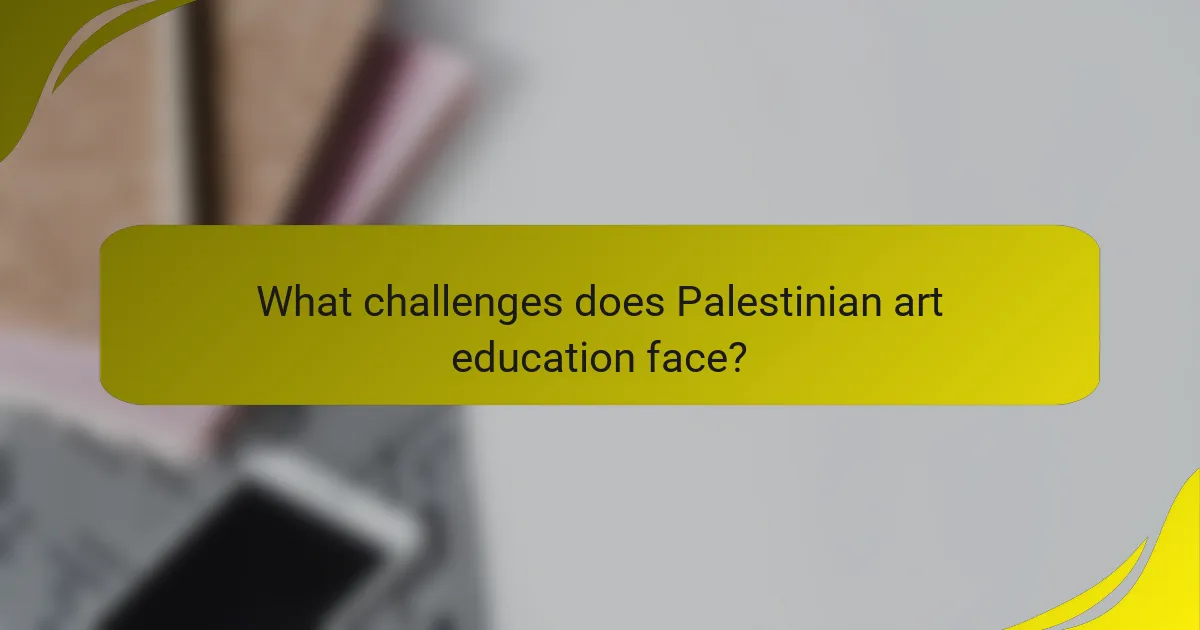
What challenges does Palestinian art education face?
Palestinian art education faces significant challenges due to political, economic, and social factors. The ongoing conflict limits access to resources and facilities for art education. Many schools lack proper funding and materials, hindering curriculum development. Additionally, restrictions on movement affect students’ ability to attend classes and workshops. Cultural censorship restricts artistic expression, impacting creativity and innovation. Furthermore, the lack of trained educators diminishes the quality of instruction. These challenges collectively undermine the potential of art education to foster community resilience and empowerment.
How do socio-political factors impact art education in Palestine?
Socio-political factors significantly impact art education in Palestine. The ongoing conflict and occupation create challenges for access to resources and infrastructure. Schools often lack funding, limiting art programs and materials. Restrictions on movement hinder students and educators from participating in workshops or exhibitions. Additionally, political tensions can influence curriculum content, affecting artistic expression. For instance, the Ministry of Education in Palestine has faced pressure regarding the portrayal of national identity in art. These factors collectively shape the quality and scope of art education, impacting students’ creative development and community resilience.
What are the barriers to access for art education in Palestinian territories?
Barriers to access for art education in Palestinian territories include political instability, limited funding, and restricted movement. Political instability often disrupts educational programs and resources. Limited funding affects the availability of materials and qualified instructors. Restricted movement due to checkpoints and barriers hinders students’ ability to attend classes. Additionally, cultural perceptions may undervalue art education. These factors collectively impede the development of art education in the region.
How do funding and resource limitations affect art education programs?
Funding and resource limitations significantly hinder art education programs. These constraints lead to reduced access to materials and facilities. Consequently, students may not receive adequate training or exposure to diverse artistic practices. With limited budgets, programs struggle to hire qualified instructors. This results in decreased quality of education and fewer opportunities for creative expression. According to a report by the National Art Education Association, 70% of art teachers cite funding as a primary barrier to effective instruction. Furthermore, resource limitations can restrict community engagement and outreach efforts. This ultimately affects the role of art education in fostering resilience and empowerment within communities.
What strategies can be employed to enhance art education in Palestine?
Enhancing art education in Palestine can be achieved through several strategies. First, integrating local culture and history into the curriculum can foster a sense of identity. This approach allows students to connect with their heritage. Second, providing access to resources and materials is crucial. Many schools lack basic art supplies, which limits creativity. Third, training teachers in modern art techniques can improve educational outcomes. Professional development workshops can equip educators with new skills. Fourth, establishing community art programs can engage families and promote collaboration. These programs can serve as platforms for local artists to mentor students. Fifth, leveraging technology can expand learning opportunities. Online platforms can connect Palestinian students with global art communities. Finally, advocating for policy changes to prioritize arts education can secure funding and support. These strategies collectively contribute to strengthening the role of art education in community resilience and empowerment in Palestine.
How can community involvement improve the effectiveness of art education?
Community involvement can significantly enhance the effectiveness of art education. Engaging local artists and community members provides students with diverse perspectives and real-world experiences. This collaboration fosters a supportive environment that encourages creativity and experimentation. Research shows that programs involving community participation lead to higher student engagement and retention rates. For instance, a study by the National Endowment for the Arts indicates that arts education linked to community projects increases student motivation. Additionally, community involvement can secure resources and funding for art programs, improving access to materials and facilities. Ultimately, this synergy between art education and community strengthens both the educational outcomes and the social fabric of the community.
What role do partnerships with local and international organizations play?
Partnerships with local and international organizations enhance Palestinian art education. They provide resources, training, and exposure to global practices. These partnerships facilitate cultural exchange and knowledge transfer. They also help in securing funding for art programs. Collaborative projects increase community engagement and participation. Organizations often bring expertise that strengthens local initiatives. Evidence shows that such partnerships lead to improved educational outcomes. For instance, programs funded by international bodies have shown increased student participation in arts.
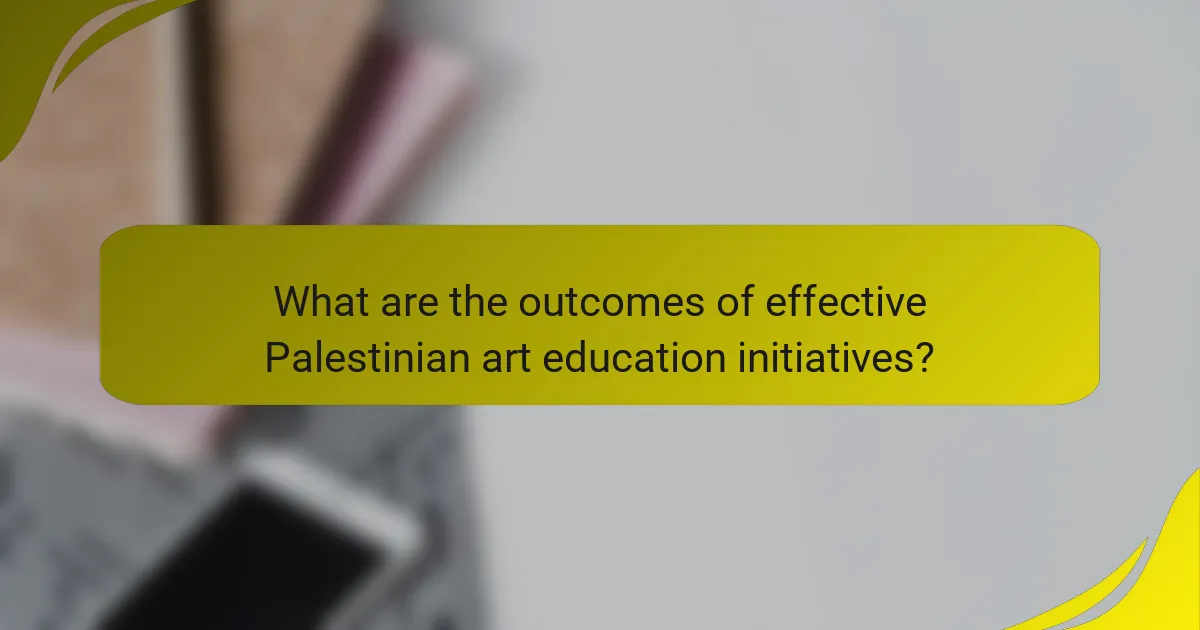
What are the outcomes of effective Palestinian art education initiatives?
Effective Palestinian art education initiatives foster community resilience and empowerment. These programs enhance cultural identity and self-expression among participants. They provide essential skills in creativity and critical thinking. Such initiatives also promote social cohesion within diverse communities. Evidence shows that art education can improve mental health and emotional well-being. For instance, workshops have led to increased confidence in youth. Research indicates that participants often engage in civic activities post-involvement. Overall, these initiatives contribute to a more vibrant and resilient society.
How do successful art education programs demonstrate resilience and empowerment?
Successful art education programs demonstrate resilience and empowerment by fostering creativity and critical thinking. They encourage students to express their emotions and experiences through art. This expression can serve as a coping mechanism in challenging environments. Programs often provide a safe space for dialogue and exploration of identity. They help build confidence and self-esteem among participants. Research shows that participation in art education can lead to improved mental health outcomes. For example, a study by the National Endowment for the Arts found that arts engagement can enhance community well-being. Additionally, these programs often promote collaboration and teamwork, strengthening community bonds.
What case studies exemplify the impact of art education on communities?
Case studies demonstrating the impact of art education on communities include the “Art for All” initiative in Palestine. This program fosters creativity among youth while addressing social issues. Participants engage in workshops that blend traditional art forms with contemporary practices. The initiative has led to increased community cohesion and empowerment. Another example is the “Cultural Resistance” project, which uses art as a means of expression in conflict zones. This project has shown measurable improvements in mental health and social engagement among participants. These case studies highlight how art education can transform communities by promoting resilience and fostering a sense of belonging.
How can success in art education be measured within Palestinian communities?
Success in art education within Palestinian communities can be measured through various indicators. These include student participation rates in art programs. Increased enrollment signifies community interest and investment in art education.
Another measure is the development of artistic skills among students. Assessments and portfolios can provide tangible evidence of skill improvement. Community exhibitions showcasing student work can also indicate success. These events foster pride and visibility for local artists.
Furthermore, the impact of art education on personal and social development is crucial. Surveys can reveal changes in self-esteem and community engagement among participants. Collaborations with local organizations can enhance the relevance and reach of art programs.
Lastly, the sustainability of art education initiatives reflects success. Long-term funding and support from local and international organizations are essential for ongoing impact. These measures collectively demonstrate the effectiveness of art education in fostering resilience and empowerment within Palestinian communities.
What practical steps can individuals take to support Palestinian art education?
Individuals can support Palestinian art education by donating to organizations that provide resources and training. These organizations often focus on underserved communities. Participating in art workshops can also help raise awareness and funds. Volunteering time and skills to teach art can directly impact students. Purchasing artwork from Palestinian artists supports their livelihoods and promotes cultural expression. Sharing information about Palestinian art education on social media can increase visibility and support. Attending exhibitions and events helps foster community engagement and appreciation for the art. Lastly, advocating for policies that support educational funding in Palestine can create systemic change.
How can community members get involved in local art education initiatives?
Community members can get involved in local art education initiatives by participating in workshops and classes. Many organizations offer programs for all ages. Volunteers can assist in teaching or organizing events. Joining local art groups fosters collaboration and creativity. Community members can also donate art supplies to support programs. Attending exhibitions and performances helps raise awareness. Engaging with local schools promotes art education integration. These actions contribute to strengthening cultural identity and community resilience.
What resources are available for supporting Palestinian art education programs?
Funding from international NGOs supports Palestinian art education programs. Organizations like the United Nations Relief and Works Agency (UNRWA) provide resources for art initiatives. Local non-profits also contribute materials and training for educators. Collaborative projects with international art institutions enhance educational offerings. Grants from cultural foundations facilitate workshops and exhibitions. Online platforms offer virtual resources and training for art teachers. Community centers often host art programs funded by local initiatives. These resources collectively strengthen art education in Palestinian communities.
The primary entity of this article is Palestinian art education, which plays a vital role in fostering community resilience and empowerment. The article explores how art education enhances self-expression, critical thinking, and collaboration among individuals, helping them process trauma and build social cohesion. It highlights the challenges faced by art education in Palestine, including political instability and funding limitations, while also discussing strategies for improvement and the positive outcomes of effective art initiatives. Through case studies and research, the article demonstrates the significant impact of art education on personal development, community bonds, and cultural identity.
